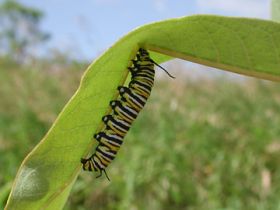Evolutionary defense system in earring plants
There is a saying that the enemy understands your weakest point very right in the case of leafy plants and creatures that evolve: When plant eaters develop a new offensive strategy, plants immediately reacting to its own special defense system.
The plant is the latest example of this reaction, according to Cornell's research, suggesting that plants may be shifting from defensive consolidation to leaf-eating worms to a more efficient method. Genetic analysis shows the evolutionary trend of earrings, shifting from resisting enemies to making efforts to heal themselves faster than caterpillars eat - especially caterpillars that eat eardrops.
Anurag Agrawal, Cornell professor of ecology and evolutionary biology, and the lead author of the latest issue of the Proceedings of the National Academy of Sciences, said: 'An important question is when Which co-evolution process ends? Then there will be a possible answer: When the price paid becomes too high. Some plants seem to have shifted from being resistant to leaf-eating creatures and using energy to heal themselves. '

Caterpillars prepare to eat a leaf of earrings.Before eating, caterpillars dissipate the natural defense system of the earring plant by slitting the leaf veins and injecting toxins and viscous blind plastic.(Photo: Anurag Agrawal)
The article is a critical link as it opens up new directions for key theories of co-evolution, showing that the pressure of feeding insects causes plants to diversify and develop new defensive tactics. That diversification follows trends in one direction or the other.
The earring has evolved to reinforce defensive tactics to counteract their leafy caterpillars. Evolutionary forms include growing hair on the leaves, generating toxins called cardenolides in the same white, milky plastic tissue in the plant's tubes. Once the caterpillar bites leaves, the resin will spill out. Agrawal said: 'It's like being thrown into the face of greasy paint.'
Some moths have adapted by scraping the leaves, then slitting a circle on the veins and eating the middle part, where there is no plastic. In addition, the earlobe moth has immunity to cardenolides.
Using DNA sequence data to understand the relationship between 38 earring species, Agrawal and colleague Mark Fishbein, a biologist at Portland State University, found the decline of the three most important resistance traits. of tree earrings (feathers, cardenolides and plastic blinds), while the ability to grow back itself increases.
Agrawal was shocked to discover that plants became more tolerant than diversifying their defenses . The reason, he predicted, was probably because the leaf-eating creature had become too adaptive, so the plant that chose the defensive tip 'suffered the damage instead of resisting it' . However, it is unclear whether the method exists in animals that escape parasites.
This finding raises questions about evolution in plants, biodiversity and key species, and gives scientists a clue on how to control insects that destroy crops to obtain. high profits.
- Video: US missile defense system shows China must be
- The best missile defense systems in the world
- Increased CO2 levels threaten princess butterflies
- Analysis of the organism genome to re-establish the evolutionary tree
- The power of the THAAD missile defense system
- Plants can hear sounds when they are eaten
- Species protect themselves when bitten
- The dinosaur fossils perfectly match the evolutionary tree
- Lockheed Martin's air defense system
- Airbus is developing a drone interception system around the airport
- The science of discovering plants also knows 'pain' when we eat
- Missile defense system for passenger aircraft
 Why do potatoes have eyes?
Why do potatoes have eyes? 'Tragedy' the world's largest carnivorous life: Death becomes ... public toilet
'Tragedy' the world's largest carnivorous life: Death becomes ... public toilet Tomatoes were once considered 'poisonous' for 200 years
Tomatoes were once considered 'poisonous' for 200 years Detecting microscopic parasites on human face
Detecting microscopic parasites on human face Top 5 plants with special abilities
Top 5 plants with special abilities  Mushrooms - The silent 'architects' of nature
Mushrooms - The silent 'architects' of nature  Technology of growing plants in the dark
Technology of growing plants in the dark  We are about to understand the language of trees.
We are about to understand the language of trees.  Can animals heal themselves?
Can animals heal themselves?  Do fake plants make us feel good?
Do fake plants make us feel good? 